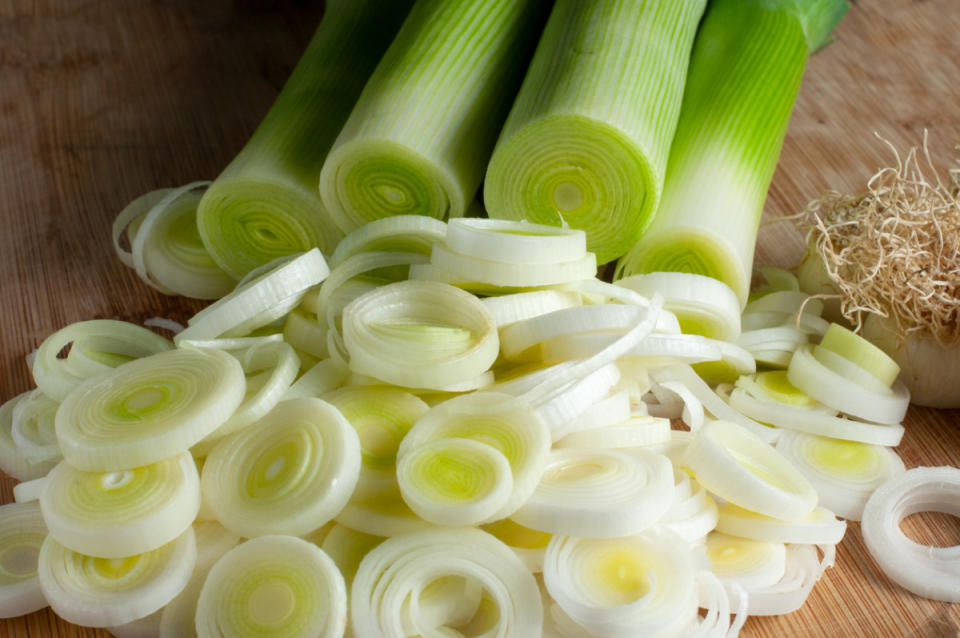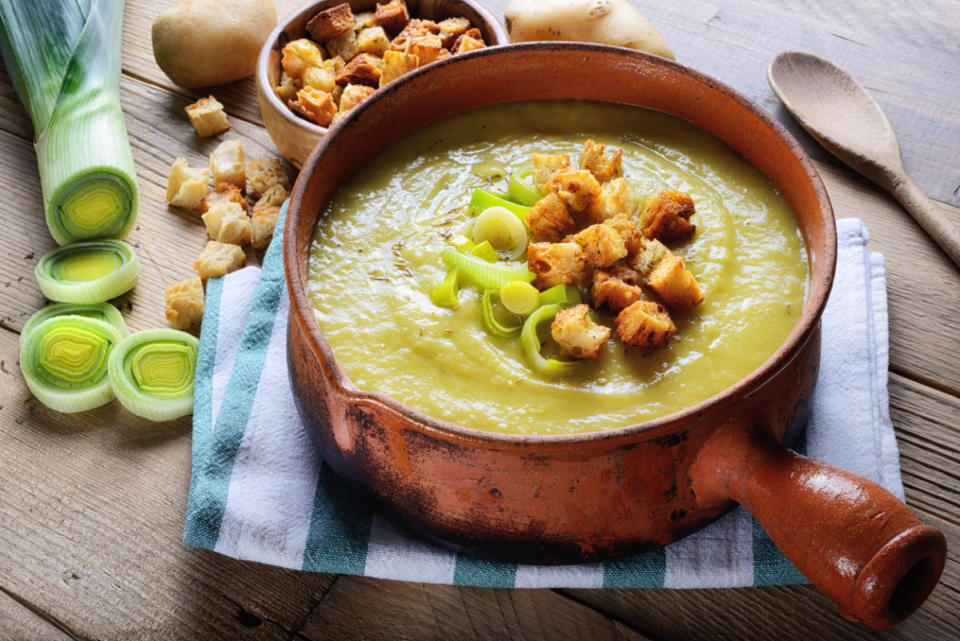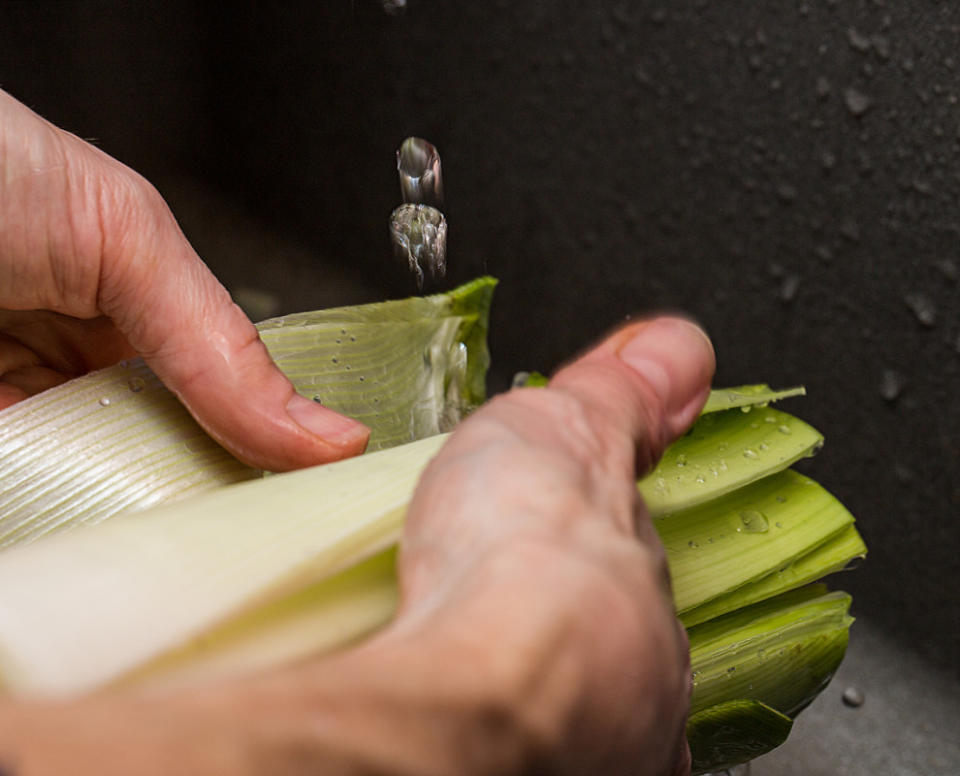Chefs Swear by This Underappreciated Veggie—Here's Why You Should Add It to Your Grocery List

Leeks in basket
Leeks are one of those vegetables you either love or probably aren't using enough. Although they can be found in grocery stores year-round, their mildly sweet flavor is perfect for springy frittatas, soups and savory tarts because they pair so well with other seasonal veggies, like peas and asparagus.
There's nothing better than the smell of leeks swimming in butter, caramelizing with shallots or onions. One waft and you'll become a bonafide leek lover and understand why chefs love this versatile vegetable.
If you're new to leeks, fear not. We've compiled a handy cheat sheet that includes everything you need to know about the allium, including how to clean, cut and cook leeks. Once you have the basics down, leeks are bound to become a go-to ingredient you turn to again and again.
Related: 50 Best Leek Recipes for Spring and Beyond

iStock
What Are Leeks?
In case there was any confusion, leeks are not green onions. Yes, they can mistaken for giant scallions (they both have rooty white bulbs and green stalks, after all), but they are in fact, very different, especially when it comes to taste and the best uses for each veggie.
Although leeks and green onions are both in the allium family—along with chives, garlic and shallots—leeks are distinguished by their long, thick, cylindrical stalks, according to Farmer Lee Jones, leek fan and founder of The Chef's Garden.
"While leeks and green onions belong to the same botanical family, they are not the same," explains Jones. "Leeks have a milder, sweeter flavor and a larger, more cylindrical shape."
Tracey Medeiros, food writer, recipe developer and author of The Vermont Farm Table Cookbook, 10th Anniversary Edition agrees that the similarities between leeks and green onions end with their verdant looks. "Leeks are larger and thicker and sold in single stalks whereas green onions, also known as scallions, are smaller and sold in bunches," she explains. "Scallions tend to have a slightly sharper flavor than leeks."
Related: How to Store Garlic So It Stays Fresh, According to Italian Cooks and Nonna-Trained Pros
When Are Leeks in Season?
Leeks, like other veggies, can be found in stores year-round because they're grown hydroponically around the world, but if you're looking for fresh, peak-season leeks, their prime growing season is typically from late fall through early spring.
"Here at The Chef's Garden, we like to keep them in the ground during the cold winter months and harvest them as wintered-over leeks," says Jones. "They provide an even sweeter flavor."
Related: Scallions vs. Green Onions: Is There a Difference?
What Do Leeks Taste Like?
Given that they are a part of the allium family, you can expect a hint of garlic flavor when you bite into a leek, notes Jones, but leeks have a milder, sweeter flavor than ramps or green onions.

iStock
The Best Way to Cook Leeks
Chef Luke Venner of Elm restaurant in New Canaan, CT likes to use gentle cooking techniques for leeks like poaching or glazing them in butter and stock to bring out their delicate flavors. Gently cooking leeks will also give them a soft, tender texture.
"Their flavor becomes much more acrid than regular onions when they are applied to high heat such as grilling," he adds. If you do want to go the charred route with your leeks, opt for fresh in-season leeks since they will produce the best sweet-meets-smoky taste.
Jones also points out that leeks can be eaten raw when young and tender or added to soups, stews and sauces to deepen their flavors. Folks who love onion rings might want to try pan-frying thinly sliced leeks. They crisp up beautifully and are great on salads or soups. You can make more than you need and store them in an airtight container at room temperature for a day or two.
The brilliance of leeks is that they pair well with a variety of vegetables, including potatoes, carrots, mushrooms and spinach, according to Jones. They also complement proteins, such as chicken, pork, beef and seafood.
"I love leeks paired with fish or poultry," says Venner. "Mushrooms and truffles dance nicely with leeks, as do citrus and alpine cheeses." For seafood, he prefers leeks with flat fish, such as halibut and turbot.
But his favorite leek dish of all time is a leek bread pudding with Comté cheese and winter truffles, inspired by Chef Thomas Keller's famed dish at his restaurant Ad Hoc in Yountville, CA. "I make it for my in-laws every Christmas Eve," he shares.
Ben Triola, Executive Chef at The Chloe in New Orleans, LA likes to slice his leeks into coins, give them a quick sauté in butter and a touch of white wine and lemon, then serve them with grilled steak.
"When seared hard on one side to char them, it makes for a beautiful presentation," he says. He's also partial to roasting leeks in butter and thyme, then topping them with fresh goat cheese and a bit of lemon zest.
And if you really want to keep things simple, you can saute some leeks in a pan until they're very soft, fold them into soft scrambled eggs and serve them on buttered toast.
Related: How to Carmelize Onions Like a Chef

iStock
The Best Way to Clean and Cut Leeks
If you're slicing leeks to cook them, Jones advises slicing them first, then rinsing the slices in a bowl of water to remove any dirt or grit that can hide between the veggie's many layers.
If you plan to serve your leeks halved for a braised appetizer or side, he recommends removing the tough dark green parts at the top of the leek and then halving the remaining leek lengthwise. "Trim off the roots but not the bottom ends," he instructs, "so that the leeks stay intact." Then rinse them under cold water, being sure that the water gets between the layers.
Related: A Step-by-Step Guide for Getting Leeks Squeaky Clean
Can You Eat the Whole Leek?
If you've been cutting the tougher green tops off your leeks and tossing them, stop right now. Jones says you can 100% eat the whole leek, including the green leaves at the top of the vegetable.
"The dark green tops are tougher and less flavorful than the white and light green parts, so they are often trimmed and reserved for making stock," he says. The leek tops will add a mildly oniony flavor to the stock, which adds a delicious savory depth of flavor to soups and sauces.
How to Store Leeks
Venner's preferred way to store leeks is to place whole, unwashed leeks in a Ziploc bag or airtight container and stash them in the fridge. "You never want to cut up produce too much beforehand," he says. "Whole leeks can stay fresh in the fridge for at least a week and you should wash them right before you're about to use them."
And although you can freeze leeks, Venner prefers not to because it can compromise their flavor and texture. "You don't freeze alliums like garlic or onions; leeks are the same," he says.
What Are Leeks Called in America?
Leeks are called leeks in the States but there are also wild leeks (aka ramps) and a type of allium in Spain called a calçot, which are larger than spring onions but smaller than leeks.
Related: 28 Sensational Spring Dinner Ideas Featuring the Best-of-the-Season Produce
Leek Recipes We Love
Now that you're clear on the basics of cleaning, cutting and cooking this delicate, multi-layered vegetable, it's time to put them to work! Try them in one of these recipes, which include a velvety soup, a flaky galette and a savory bread pudding studded with bacon and artichokes.
Up next: Martha Stewart’s Trick for Getting Garlic Smell Off Your Fingers

